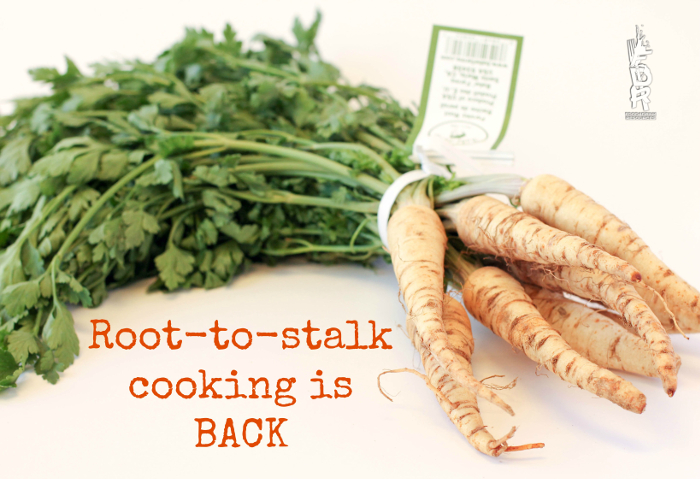Root-to-stalk cooking, the concept of using the whole fruit or vegetable, is a growing trend in the United States. But the concept isn’t new. It’s already a way of life for “waste not” generations and people all around the world.
 This article was published in May 2016; revised in December 2022.
This article was published in May 2016; revised in December 2022.
Perhaps it’s the relative prosperity and comfort that the U.S. has experienced over the last 50 years or so, but Americans have become very particular about what they will eat. Lesser cuts of meat have been overlooked in favor of the tenderloin, ribeye, strip, and chop. Produce is peeled, trimmed, cored and the scraps are thrown away. Most people don’t even know that it’s possible to cook with kale ribs, watermelon rinds, corn cobs, and the tops of leeks.
What’s Old Is New Again
Root-to-stalk cooking is making a comeback in professional and home kitchens. It’s less wasteful, saves money, and your customers care about this sort of thing.
- Every year, Americans throw out $165 billion worth of food. Much of this waste happens in the kitchen.
- The culinary world is getting savvy to the problem. Food waste reduction and management is on National Restaurant Association’s top 20 food trends list for 2016. (Report no longer available.)
- Restaurants go through a considerable amount of produce, and throwing away the scraps is like throwing away money. Use the whole vegetable and you improve your bottom line.
- As Fergus Henderson, author of The Whole Beast, says, “If you’re going to kill the animal it seems only polite to use the whole thing.” The same could be true for fruits and vegetables. (Article no longer available.)
Food Scraps
Scraps might be the new ingredient you (and your guests) have been searching for.
- The only thing that chefs love more than working with high-end ingredients is turning trash into treasure. Look at what Dan Barber of Michelin-starred restaurant, Blue Hill, is doing in New York. In 2015, along with prominent guest chefs, he temporarily turned Blue Hill into wastEd, a restaurant where guests indulged in meals made from ugly, underused ingredients like beef tallow, skate cartilage, vegetable pulp, and waste-fed pigs.
- Feeding the 5000 is a free food festival based on the same concept. Why go on a search for the next new ingredient when there are so many possibilities right under your nose?
- Today’s diners are on the lookout for new experiences. Using fruit and vegetable scraps gives them different textures, flavors, and the knowledge that the chef is cooking intentionally.
Root-To-Stalk Cooking Tips
- Use your scraps for stock. Please tell us you’re doing this already.
- Bring texture and depth to salads or sauteed dishes with carrot or turnip greens, beet or cabbage leaves, shaved broccoli, or pickled kale stems. (More about fermentation and pickling in this blog post.)
- Enrich soups by simmering with corn cobs, shelled pea pods, and leek tops.
- If you stumble upon some parsley still attached to the root, use it like FDR chef Katie Sutton does. Roast and then mash parsley root, or puree it and add it to soup.
- Pickle it. Pickling tenderizes and adds flavor to tough scraps like cabbage stems, kale and chard ribs, and watermelon rind.
- Avoid these scraps (they’re mildly poisonous): rhubarb leaves, green potato skins, seeds/pits of apples, pears, mangoes, and apricots.
Get your creative juices flowing and save some money while you’re at it, but spare yourself the embarrassment and skip telling your grandparents or that French chef you know about this new “trend.”
Learn more about 2016 food trends in this article on Food & Drink Resources’ website.
Thanks for stopping by and reading the Food & Drink Resources blog. Here we talk about food trends, culinary innovation, and the work of our team.
